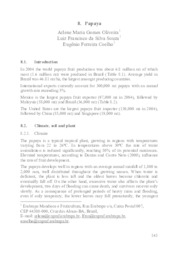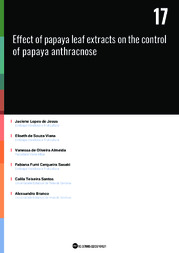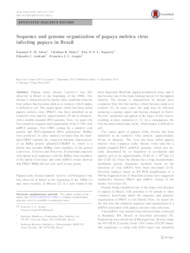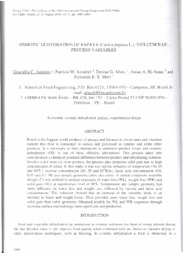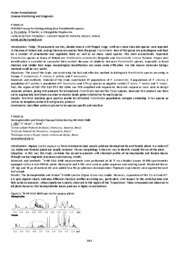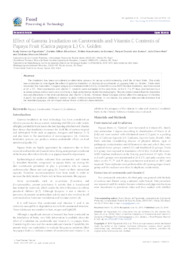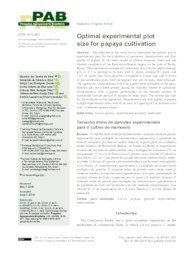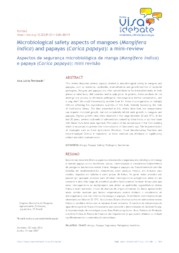Search Publications
Filter by:
| Author(s): OLIVEIRA, A. M. G.; SOUZA, L. F. da S.; COELHO, E. F. In 2004 the world papaya fruit production was about 6.89 million mt of which most (1.6 million mt) were produced in Brazil. A verage yield in Brazil was 46.81 mt/ha, the largest amongst producing coun... ... |
| Author(s): OLIVEIRA, E. J. de; AMORIM, V. B. O.; MATOS, E. L. S.; COSTA, J. T.; CASTELLEN, M. da S.; PADUA, J. G.; DANTAS, J. L. L. A set of 81 new microsatellite markers for Carica papaya L. previously identified by data mining using freely available sequence information from Genbank were tested for polymorphism using 30 germplas... ... |
| Author(s): JESUS, J. L. de; VIANA, E. de S.; ALMEIDA, V. DE O.; SASAKI, F. F. C.; SANTOS, C. T.; BRANCO, A. ABSTRACT: Objective: The objective of this study was to evaluate whether extracts with different polarities, obtained from papaya (Carica papaya) leaves, have fungicide and/or fungitoxic action in the... ... |
| Author(s): ABREU, E. F. M.; DALTRO, C. B.; NOGUEIRA, E. O. P. L.; ANDRADE, E. C.; ARAGAO, F. J. L. Papaya sticky disease ('meleira') was first observed in Brazil at the beginning of the 1980s. The disease is characterized by intense latex exudation from the fruit surface that becomes dark as it oxi... ... |
| Author(s): ANTONIO, G. C.; AZOUBEL, P. M.; ALVES, D. G.; EL-AOUAR, A. A.; MURR, F. E. X. Brazil is the biggest world producer 01' papaya and because its sweet taste and vitamins content this fruit is consumed in natura and processed in candies and some other products. lt is necessary to f... ... |
| Author(s): LIÃO, L.; VIEIRA, T.; FARIA, J. Papaya (Carica papaya L.) from commercial seed usually produce hermaphroditic and female plants in a ration of 2:1. Males and females plants are usually removed. Flower morphology is the only way to i... ... |
| Author(s): FIGUEIREDO, S. G. DE; SILVA-SENA, G. G.; SANTANA, E. N. DE; SANTOS, R. G. DOS; OIANO NETO, J.; OLIVEIRA, C. A. de The irradiation has been considered an alternative process for decay control extending shelf life of fresh fruits. This study was conducted to investigate the effect of gamma irradiation on functional... ... |
| Author(s): SILVA, M. dos S. da; SILVA, S. de O. e; DONATO, S. L. R.; LEDO, C. A. da S.; SAMPAIO FILHO, O. M.; SILVA, G. de M. A. The objective of this work was to determine the optimal size of experimental plots for the evaluation of agronomic characteristics and fruit quality of papaya, by the linear model of plateau response,... ... |
| |
| Author(s): SOUZA JUNIOR, M. T.; NICKEL, O.; GONSALVES, D. Translatable and nontranslatable versions of the coat protein (cp) gene of a Papaya ringspot virus (PRSV) isolate collected in the state of Bahia, Brazil, were engineered for expression in Sunrise and... ... |
Observation
Some of Embrapa's publications are published as ePub files. To read them, use or download one of the following free software options to your computer or mobile device. Android: Google Play Books; IOS: iBooks; Windows and Linux: Calibre.
Access other publications
Access the Agricultural Research Database (BDPA) to consult Embrapa's full library collection and records.
Visit Embrapa Bookstore to purchase books and other publications sold by Embrapa.

